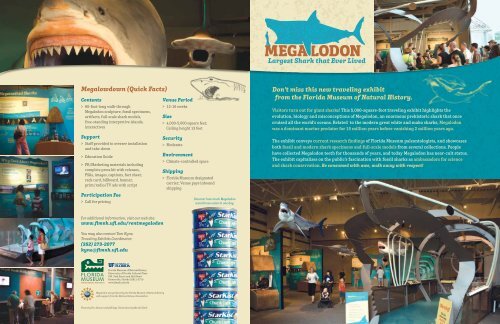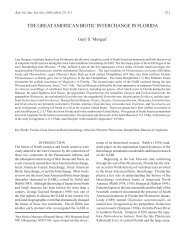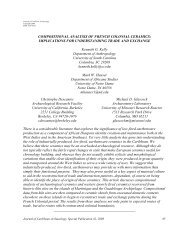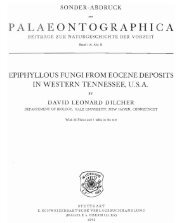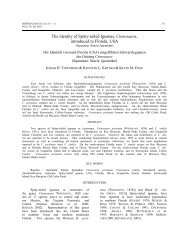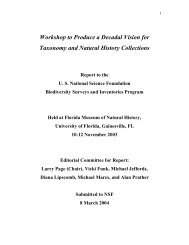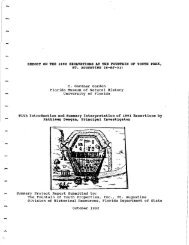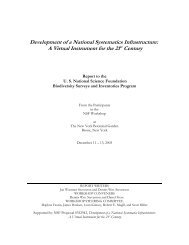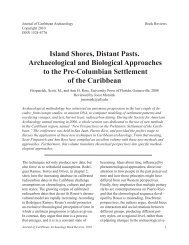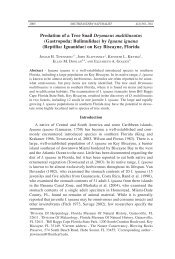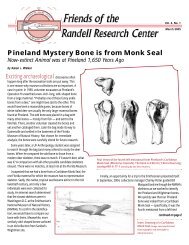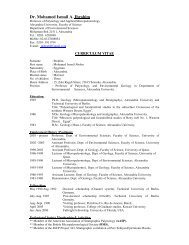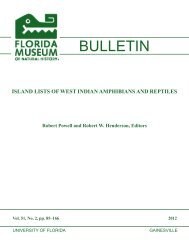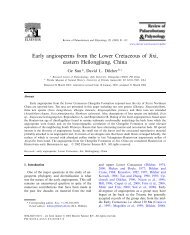Download Brochure PDF - Florida Museum of Natural History ...
Download Brochure PDF - Florida Museum of Natural History ...
Download Brochure PDF - Florida Museum of Natural History ...
Create successful ePaper yourself
Turn your PDF publications into a flip-book with our unique Google optimized e-Paper software.
Megalowdown (Quick Facts)<br />
Contents<br />
> 60-foot-long walk-through<br />
Megalodon sculpture, fossil specimens,<br />
artifacts, full-scale shark models,<br />
free-standing interpretive islands,<br />
interactives<br />
Support<br />
> Staff provided to oversee installation<br />
and take-down<br />
> Education Guide<br />
> PR/Marketing materials including<br />
complete press kit with releases,<br />
PSAs, images, captions, fact sheet;<br />
rack card, billboard, banner,<br />
print/radio/TV ads with script<br />
Participation Fee<br />
> Call for pricing<br />
For additional information, visit our web site:<br />
www.flmnh.ufl.edu/rentmegalodon<br />
You may also contact Tom Kyne,<br />
Traveling Exhibits Coordinator:<br />
(352) 273-2077<br />
kyne@flmnh.ufl.edu<br />
<strong>Florida</strong> <strong>Museum</strong> <strong>of</strong> <strong>Natural</strong> <strong>History</strong><br />
University <strong>of</strong> <strong>Florida</strong> Cultural Plaza<br />
S.W. 34th Street and Hull Road<br />
Gainesville, <strong>Florida</strong> 32611-2710<br />
www.flmnh.ufl.edu<br />
Megalodon was produced by the <strong>Florida</strong> <strong>Museum</strong> <strong>of</strong> <strong>Natural</strong> <strong>History</strong><br />
with support from the National Science Foundation.<br />
Photos by Eric Zamora and Jeff Gage. Illustrations by Merald Clark.<br />
Venue Period<br />
> 12-16 weeks<br />
Size<br />
> 4,000-5,000 square feet;<br />
Ceiling height 13 feet<br />
Security<br />
> Moderate<br />
Environment<br />
> Climate-controlled space<br />
Shipping<br />
> <strong>Florida</strong> <strong>Museum</strong> designated<br />
carrier; Venue pays inbound<br />
shipping<br />
Discover how much Megalodon<br />
would have eaten in one day.<br />
Don’t miss this new traveling exhibit<br />
from the <strong>Florida</strong> <strong>Museum</strong> <strong>of</strong> <strong>Natural</strong> <strong>History</strong>.<br />
Visitors turn out for giant sharks! This 5,000-square-foot traveling exhibit highlights the<br />
evolution, biology and misconceptions <strong>of</strong> Megalodon, an enormous prehistoric shark that once<br />
cruised all the world’s oceans. Related to the modern great white and mako sharks, Megalodon<br />
was a dominant marine predator for 15 million years before vanishing 2 million years ago.<br />
The exhibit conveys current research findings <strong>of</strong> <strong>Florida</strong> <strong>Museum</strong> paleontologists, and showcases<br />
both fossil and modern shark specimens and full-scale models from several collections. People<br />
have collected Megalodon teeth for thousands <strong>of</strong> years, and today Megalodon has near-cult status.<br />
The exhibit capitalizes on the public’s fascination with fossil sharks as ambassadors for science<br />
and shark conservation. Be consumed with awe, walk away with respect!
About the Exhibit<br />
The exhibit centerpiece is a 60-foot-long metal sculpture <strong>of</strong> an adult Megalodon. Visitors walk<br />
through its jaws and begin to explore the story <strong>of</strong> this fantastic ancient creature–its size, structure,<br />
diet, lifespan, relatives, neighbors, evolution, extinction and the science that continues to reveal<br />
Megalodon’s tale. Designed in a flexible modular format, stand-alone stories are illustrated by<br />
large, colorful graphics, shark-tooth-shaped display cases, hands-on components, and family-friendly<br />
interactives. The exhibit is object-rich, including numerous fossil specimens from several<br />
collections, and life-size and scale models <strong>of</strong> other fossil and modern sharks.<br />
Exhibit Walk-Through<br />
Enter at Your Own Risk! Megalodon, a dominant<br />
marine predator for 15 million years before vanishing two<br />
million years ago, provides lessons for shark conservation today.<br />
Enter the shark to begin exploring.<br />
If Shark Teeth Could Talk.... Shark teeth can identify the species,<br />
suggest body size and indicate prey or prey size. Touch a full set <strong>of</strong> 46 Megalodon<br />
teeth, and view real specimens showing tooth differences between upper and lower<br />
jaws, male and female sharks, and sharks’ unique system <strong>of</strong> tooth replacement.<br />
This Was One Big Shark! Scientists still debate Megalodon’s size.<br />
Measure a series <strong>of</strong> hands-on Megalodon teeth to predict the size <strong>of</strong> each shark.<br />
Circle <strong>of</strong> Life Growth rings are visible in shark vertebrae or “centra,” much<br />
like tree rings, and indicate a shark’s age at death. Turn a wheel with shark centra<br />
to magnify and count rings to estimate age.<br />
What Did Megalodon Eat? (Anything it wanted!) Megalodon was<br />
the top predator <strong>of</strong> its time. Calculate the volume <strong>of</strong> tuna cans that represents an<br />
average daily meal.<br />
When Did Megalodon Live? Megalodon lived from 17 to 2 million years ago<br />
when the world’s oceans were generally warmer. Compare Megalodon’s time on earth<br />
to dinosaurs, humans and other animals. See fossils <strong>of</strong> some <strong>of</strong> Megalodon’s neighbors.<br />
Where Did Megalodon Live? Megalodon lived throughout ancient oceans.<br />
Touch Megalodon teeth from around the world and with buttons locate where these<br />
fossils were found on a world map.<br />
Shark Tooth Study Center Shark teeth are the most commonly collected<br />
fossils. Bring your own shark teeth or use those provided to compare to the 52<br />
species on display. Watch video <strong>of</strong> kids collecting fossil teeth in a <strong>Florida</strong> stream.<br />
Megalodon’s Extended Family Megalodon is related to mackerel<br />
sharks, including the modern great white and mako. View mackerel shark<br />
specimens and identify what makes them unique.<br />
Megatoothed Sharks Megalodon belongs to a group <strong>of</strong> giants called<br />
megatoothed sharks – all now extinct. Discover when each species lived and<br />
see the diversity <strong>of</strong> their tooth shapes and sizes.<br />
Ancient Sharks Sharks have been around<br />
for over 400 million years. View models <strong>of</strong> some <strong>of</strong><br />
these curious early sharks and the specimens<br />
that give us clues.<br />
Sharks & Company There are more than 375 species <strong>of</strong> sharks living<br />
today. They are related to skates, rays and ratfish. See specimens <strong>of</strong> these<br />
fishes and view six full-scale models, including a 22-foot great white.<br />
Megalodon Extinction Several factors caused Megalodon’s extinction<br />
about 2 million years ago. Climate change and shifting food resources are part<br />
<strong>of</strong> the story. Learn about extinction and guess which <strong>of</strong> five modern animals<br />
are in danger <strong>of</strong> extinction today.<br />
Why Care About Megalodon? Megalodon teaches us about shark<br />
evolution and shark conservation today. Learn what you can do to help.<br />
Who Needs Sharks? You Do. Watch video about shark conservation<br />
and pull a lever to reveal the role sharks play in ocean health.<br />
Shark Research at the <strong>Florida</strong> <strong>Museum</strong> The <strong>Florida</strong> <strong>Museum</strong><br />
<strong>of</strong> <strong>Natural</strong> <strong>History</strong> has one <strong>of</strong> the most active shark research programs in<br />
the world. Watch a video about shark research.<br />
Megalomania Megalodon has intrigued people for thousands <strong>of</strong> years,<br />
and still intrigues us today. View Megalodon teeth used by ancient Native<br />
Americans, and see modern books, clothing and jewelry inspired by Megalodon.<br />
Fact or Fiction? There are plenty <strong>of</strong> common misconceptions about<br />
sharks. Compare Megalodon’s place in time to dinosaurs and humans, and<br />
learn how unlikely it is today to be attacked by a shark.<br />
Growth Series <strong>of</strong> Megalodon Jaws View four Megalodon jaws<br />
from 30- to 60-foot-long sharks – a perfect backdrop for family photos.<br />
Interactives<br />
> Photo opportunity at jaws at<br />
Megalodon sculpture entrance<br />
> Three exhibit modules with<br />
touchable shark teeth<br />
> World map with push-button lights<br />
to see Megalodon fossil locations<br />
> Study center with 32 specimen<br />
identification drawers<br />
> Tuna can pyramid with<br />
meal volume calculator<br />
> Shark size interactive<br />
> Rotating wheel with “count the rings”<br />
shark centra (vertebrae)<br />
> Overfishing interactive<br />
> Ten flip-up Q&A’s<br />
> Three video displays (shark-tooth<br />
collecting, shark research, shark<br />
conservation)<br />
> Photo opportunity behind series<br />
<strong>of</strong> four large shark jaws


